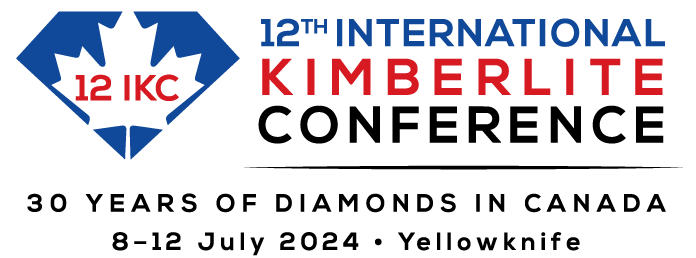KEYNOTES
Jon Carlson:
Canada’s Entry into Global Diamond Production: The Ekati and Diavik Discoveries

SHORT ABSTRACT:
The exciting discovery of diamondiferous kimberlites in Canada’s Northwest Territories 30 years ago triggered the last great Canadian staking rush culminating in the opening of the Ekati and Diavik diamond mines. Canada has produced more than three hundred million carats to date from mining operations in the NWT, Nunavut, Ontario, and Quebec and remains a significant global diamond producer. This presentation examines the sequence from discovery to evaluation to diamond production for these two iconic Canadian diamond mines.
BIO:
Jon Carlson has been directly involved with kimberlite exploration and mining for his entire career including 30 years at Ekati working through the complete stages of exploration to project evaluation to mining operations. His experience dates to the early exploration days, working with Chuck Fipke, Dia Met and BHP on the area that would become the Ekati Diamond Mine. He played an integral role in the discovery and evaluation of kimberlites on the Ekati property.
Sergei Lebedev:
Seismic Thermography of Continental Lithosphere: Structure, Evolution, and Controls on the Distribution of Kimberlites and Other Mineral Deposits

SHORT ABSTRACT:
The structure, thickness, lateral heterogeneity and temporal evolution of the lithosphere control the distribution of kimberlites, carbonatites and sediment-hosted mineral deposits. Seismic data are our primary source of information on the thermal structure of the lithosphere and underlying mantle at present. Igneous petrology and geochemistry yield evidence on the structure and dynamic processes at the time of volcanic-rock eruptions. Joint analysis of these lines of evidence offers insights into the evolution of continental lithosphere over its long history. Thermodynamic inversion of seismic data directly for temperature at depth, with constraints from other data types, amounts to Seismic Thermography of the Earth’s interior. Seismic thermography avoids the errors that commonly result from the conversion of non-unique seismic models to temperature or lithospheric thickness. It produces accurate models of the lithosphere and upper mantle, with important inferences on their dynamics and evolution and on the mechanisms that control the distributions of the mineral deposits.
BIO:
After a PhD on seismic waveform tomography at Princeton, Sergei worked at MIT, Utrecht University and the Dublin Institute for Advanced Studies and is now Professor of Geophysics at the University of Cambridge. His interests include seismic imaging at different scales (from the global to mineral-deposit scale), thermodynamic inversion of seismic and other data for the thermal structure of the lithosphere and underlying mantle, and the lithospheric controls on magmatism, mineral deposits and seismicity.
Suzette Timmerman:
Sublithospheric diamond ages and their geodynamic implications

SHORT ABSTRACT:
We will review recent progress in dating sublithospheric diamonds and discuss their link to the supercontinent cycle and their vertical and horizontal transport history. Through full laser ablation of complex, retrogressed Ca-silicate inclusions in sublithospheric diamonds, we can obtain coeval Rb-Sr, Sm-Nd, and U-Pb ages within analytical uncertainties. This method has been applied to Ca-silicates in diamonds from the Juina area, Brazil and Kankan, Guinea, and revealed diamond formation events during the time of Gondwana assembly when a supercontinent subduction-ringing system focused recycled material in the Southern Hemisphere’s sublithospheric mantle. For these diamonds to erupt through the Amazonian and West-African cratonic lithosphere, the diamonds and continents must have travelled together during continental drift. The most likely model to bring diamonds up to the base of the lithosphere prior to major plate movements is with the rise of buoyant depleted mantle material, a mechanism that can help grow mantle roots, weld, and stabilize continents from below.
BIO:
Suzette first became fascinated by diamonds during her Masters at the VU University Amsterdam and subsequently worked on noble gases in fluid inclusions in diamonds for her PhD at the Australian National University. After a post-doc on sulfur isotopic compositions of mafic glasses at the University of Münster, she worked on dating sublithospheric inclusions in diamonds during a Banting post-doctoral fellowship at the University of Alberta, Canada. She currently leads the Isotope Geology group at the Institute of Geological Sciences at the University of Bern, focusing on the fate of (ultra-)depleted mantle using a variety of mantle-derived samples (e.g., xenoliths, diamonds, abyssal peridotites, ophiolites).
Andy Davy and Malcolm Thurston:
Estimating diamond price for mineral resources and reserves; new observations and insights


SHORT ABSTRACT:
The principal objectives of our talk are to share the observations and highlight the risks associated with this critically important step in the evaluation of economic kimberlites.
In previous years diamond price estimation for mineral resources and reserves was considered “confidential” but, as more junior companies have become producers, the requirement for transparency has resulted in the public disclosure of data, methods and prices (actual and modelled). In Canada, guidelines issued by the CIM to Qualified Persons provide a framework for reporting resources and reserves. These guidelines were released in 2008 and16 years later warrant updating. In preparing revised guidelines, we have made observations and developed new insights that will result in improved guidance on the uncertainty associated with price estimates generated from bulk sampling.
ANDY DAVY BIO:
Andy provides technical advice to clients in the diamond exploration and mining industries on ore body evaluation, grade and price estimation, diamond damage assessment, resource and reserve estimation, reconciliation, diamond sorting & valuation, rough diamond supply, assessment of new business opportunities, project studies, governance and reporting. He has worked in the diamond industry for 45 years and was employed by Rio Tinto for 33 years. Prior to joining Rio Tinto, Andy held a number of senior technical roles in De Beers and BP Minerals. He has a BSc in Geology & Chemistry from the University of Newcastle-upon-Tyne and a PhD in Mineral Technology from the Royal School of Mines, Imperial College, London. Andy was lead Editor for an SEG Special Publication “Geoscience and Exploration of the Argyle, Bunder, Diavik and Murowa Diamond Deposits” released in 2018, and has given numerous talks at the Prospectors & Developers of Canada Convention (PDAC), previous International Kimberlite Conferences, and the Vancouver Kimberlite Cluster.
MALCOLM THURSTON BIO:
Malcolm has more than 40 years’ experience in the minerals industry with in-depth knowledge of mineral resource estimation in diamonds. During this time, he held various positions with De Beers and Anglo American and worked as a mineral resource consultant gaining specialized experience in third party auditing. Malcolm has work experience in the UK, South Africa, the USA, and Canada and has travelled to Kimberlites around the world. Malcolm retired in 2022 as the Head of Mineral Resource Management for De Beers Group where he provided guidance and leadership in all aspects of mineral resource estimation. He is now an independent consultant providing evaluation guidance to mining clients in the diamond industry. Malcolm holds a B.Sc. (Honours) degree in Mining Geology from the Royal School of Mines, Imperial College London, UK, a Diplôme d’Études Approfondies (Option Geostatistics) from the Paris School of Mines, France, and a Ph.D. (mining engineering) from the University of the Witwatersrand, Johannesburg, South Africa. Malcolm has co-authored several publications on resource estimation and geostatistics and presented numerous external talks including presentations for the Canadian Institute of Mining, Metallurgy and Petroleum (CIM), the Prospectors & Developers Association of Canada (PDAC), the APGO and the Vancouver Kimberlite Cluster.
Max W. Schmidt:
A universal concept of melting in mantle upwellings: all deep melts are born kimberlitic

SHORT ABSTRACT:
We have forced primitive MORB, various OIBs and kimberlite melts into equilibrium with olivine-cpx-opx-garnet at 7 GPa and adiabatic temperature (1450 oC) using 1, 5, and 5-20 wt% CO2, respectively, and 1-2 wt% H2O. The resultant melts are all similar and kimberlitic (but not carbonatitic). In upwellings, 7 GPa corresponds to the depth where elemental carbon may be oxidized to CO2, which then lowers the mantle melting temperature by ~300 oC, i.e. to values below the adiabat, resulting in redox melting at ~250 km depth. With decreasing pressure along a mantle adiabat, these melts then evolve from kimberlitic to melilititic to basanitic to alkali basalts. We hence posit that the depth of last equilibration in the mantle determines what issues at the surface.
BIO:
Max W. Schmidt, Austrian, is since 2001 professor of experimental petrology at ETH Zürich, with previous stations in Clermont-Ferrand (F) and Bayreuth (D). His scientific career was first based on simple system experiments and their thermodynamic analysis and on subduction zone processes, in particular devolatilization of the slab. Nevertheless, his research interests are now in the diversity of mantle derived melts with a particular focus on redox-related processes and kimberlitic to alkaline melts s.l.. Larger field studies were done on the deep Kohistan arc, on ophiolites and potassic arc rocks in Western Mongolia and now on 500 Ma post-orogenic magmatism in Brazil and Namibia.
